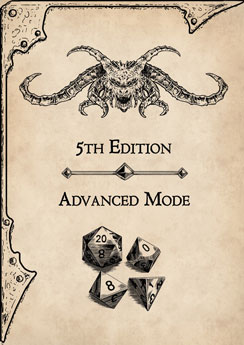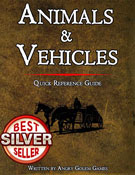Gargantuan monstrosity, unaligned
Armor Class 15 (natural armor)
Hit Points 248 (16d20 + 80)
Hit Points (suggested) 269 (18d20 + 80)
Speed 20 ft., fly 120 ft.
Proficiency Bonus +4
Proficiency Bonus +7 (5th Edition Advanced Mode)
| STR | DEX | CON | INT | WIS | CHA |
|---|---|---|---|---|---|
| 28 (+9) | 10 (+0) | 20 (+5) | 3 (-4) | 10 (+0) | 9 (-1) |
Saving Throws Dex +4, Con +9, Wis +4, Cha +3
Saving Throws (suggested) Str +13, Dex +4, Con +9, Wis +4, Cha +3
Skills Perception +4
Senses passive Perception 14
Languages –
Challenge 11 (7,200 XP)
Dive Attack (suggested). The roc can perform a dive attack if it attacks from a height of 200 feet at least. While doing so, the roc gains advantage with both talon attacks and inflicts double damage.
Grab on the Fly (suggested). If the roc succeeds in at least one talon attack while performing the Dive Attack, then a target of Huge or smaller size is automatically grappled. The next round, the target may attempt to escape the grapple (escape DC 21) or can attack the roc with disadvantage. The roc can release the grapple at any moment and have the target suffers appropriate fall damage.
Keen Sight. The roc has advantage on Wisdom (Perception) checks that rely on sight.
ACTIONS
- Multiattack. The roc makes two attacks: one with its beak and one with its talons.
- Multiattack (suggested). The roc makes two attacks with its talons or one attack with its beak.
- Beak. Melee Weapon Attack: +13 to hit, reach 10 ft., one target. Hit: 27 (4d8 + 9) piercing damage.
- Talons. Melee Weapon Attack: +13 to hit, reach 5 ft., one target. Hit: 23 (4d6 + 9) slashing damage, and the target is grappled (escape DC 19). Until this grapple ends, the target is restrained, and the roc can’t use its talons on another target.
- Talons (suggested). Melee Weapon Attack: +13 to hit, reach 15 ft., one target. Hit: 19 (3d6 + 9) slashing damage, and the target is grappled (escape DC 21). Until this grapple ends, the target is restrained and automatically takes 19 (3d6+9) damage from constriction. The roc can’t use its talons on another target.
5th Edition Advanced Mode
Limiting the power of a character and making the overall difficulty of the game harder, does not reduce the creativity, indeed it does quite the opposite.
The Game Master has the option to use any and all of the instances proposed in this guide, or just some of them according to their preference.
It is the lack of something that move and motivate characters, not the abundance of it
DESCRIPTION
A roc is a gargantuan bird of prey that resembles a massive eagle. Its feathers are usually brown or black, but in rare cases they can be golden, red, or white. Its eyes are keen and piercing. A roc’s wingspan can reach up to 200 feet, and its body can measure up to 80 feet long. A roc’s beak and talons are powerful enough to rend flesh and crush bones, and its flight speed is unmatched by any other creature in the sky. Rocs are legendary creatures that inspire awe and fear in those who witness them.
COMBAT
Rocs are not aggressive by nature, but they will defend their territory and their young from any perceived threat. They also hunt for large prey, such as elephants, whales, or even dragons, to feed themselves and their offspring. A roc can spot a potential target from miles away, thanks to its keen sight. It then swoops down from the clouds, grabbing its prey with its talons and lifting it into the air. A roc can carry up to four tons of weight with ease, and it will either drop its prey from a great height or tear it apart with its beak. A roc can also use its wings to create powerful gusts of wind that can knock down or disorient its enemies. Rocs are formidable opponents that can challenge even the most powerful adventurers.
A roc usually cruises at a height of about 300 feet, seeking out likely prey with its sharp eyes. When a good target is found, it swoops down silently. Most of the time a roc carries off its prey only if both claws hit. If the prey was hit by only one claw, the roc usually lets go, then turns around and attempts another grab. Once the prey has been secured, the roc flies back to its nest. If the creature resists, the roc strikes with its beak.
Rocs are occasionally tamed and used by cloud giants or storm giants. Good-aligned giants do not allow their rocs to attack civilized areas and the animals therein.
HABITAT / SOCIETY
Rocs are solitary creatures that prefer to live in remote and mountainous regions, where they can nest in high cliffs or caves. They are fiercely territorial and will attack any intruders that come near their nests. Rocs mate for life and produce one or two eggs every few years. The eggs are enormous, measuring up to 15 feet in diameter, and take a year to hatch. The hatchlings are dependent on their parents for food and protection until they reach maturity, which can take up to 50 years. Rocs have a lifespan of several centuries, and they grow larger as they age.
Roc lairs are vast nests made of trees, branches, and the like. They inhabit the highest mountains in warm regions. Rocs are not given to nesting close to each other, with a nest rarely being located within 20 miles of another nest. There is a 15% chance of finding 1d4+1 eggs in a roc nest. These eggs sell for 2d6×100 gp to merchants specializing in exotic items. As may be expected, rocs fight to the death to protect these nests and their contents.
The treasure of a roc is usually strewn about and below the nest, for the creature does not value such. It is the residue from its victims. If the roc has been seizing pack horses and mules, some of that treasure may be merchant’s wares such as spices, rugs, tapestries, perfume, rich clothing, or jewels.
Rocs are revered by some cultures as symbols of strength, freedom, and majesty, while others fear them as harbingers of doom or divine wrath. Rocs have no interest in treasure or civilization, but their feathers, eggs, and bones are highly prized by collectors and craftsmen.
ECOLOGY
Rocs are apex predators that have few natural enemies, except for dragons, giants, or other rocs. They play an important role in maintaining the balance of nature, as they cull the populations of large herbivores and prevent them from overgrazing or depleting the resources of their habitats. Rocs also scavenge on carrion and dead whales, helping to recycle organic matter and nutrients.
Rocs serve to keep down the number of large predators, as they are fond of ankheg, purple worms, and harpies. Thanks to the rocs’ prodigious appetites, these creatures are not swarming about with impunity.
It is said that roc feathers can be used in the manufacture of Quaal’s feather tokens, as well as wings and brooms of flying.
One race that has little love for rocs is dwarves. Dwarven mines located in remote mountains often have to contend with unruly rocs intent on protecting their territory. Attempts by the dwarves to tame rocs have all met with failure, so the accepted manner of dealing with rocs is to kill them and smash their eggs.
Adventurers who happen on a community of mountain dwarves may find employment as roc hunters. Such groups would do well not to allow any druids to find this out.
Rocs can be used as mounts or pulling animals for vehicles.
The statistics are detailed in the D&D 5e Animals & Vehicles reference guide. Just have a look at the preview on DrivethruRpg.

